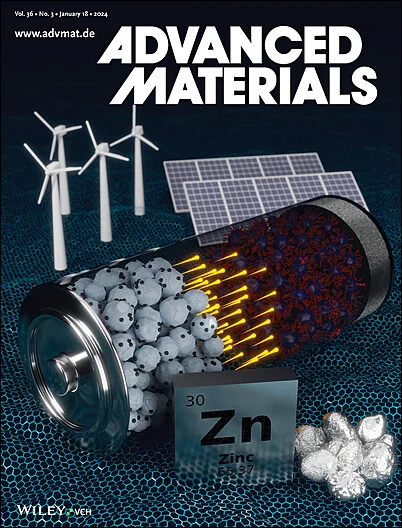Vacancy Functionalized MoS2 Nanolaminated Membranes for Efficient Sieving in Forward Osmosis
IF 26.8
1区 材料科学
Q1 CHEMISTRY, MULTIDISCIPLINARY
引用次数: 0
Abstract
2D transition‐metal dichalcogenides (TMDs) based nanolaminates are promising candidates for water purification. However, fabricating nanochannels with tunable capillary widths remain a challenge. This study proposed a sulfur vacancy functionalization strategy for fabricating high performance nanolaminate membranes by grafting three kinds of thiol (S‐H) containing molecules (Cysteine, 3‐Mercapto‐1,2‐propanediol, 1‐Propanethiol) on MoS正向渗透中高效筛分的空位功能化二硫化钼纳米膜
基于过渡金属二硫化物(TMDs)的二维纳米层合材料是水净化的有希望的候选者。然而,制造具有可调毛细管宽度的纳米通道仍然是一个挑战。本研究提出了一种硫位功能化策略,通过在二硫化钼纳米片上接枝三种硫醇(S‐H)分子(半胱氨酸、3‐巯基醇‐1、2‐丙二醇、1‐丙硫醇)来制备高性能纳米层膜,其中丙硫醇功能化的二硫化钼膜在正向渗透(萃取溶液:蔗糖溶液)中表现出最佳的阻盐性(99.3%)和水/盐选择性(800 bar−1)。发现毛细宽度从原始二硫化钼的0.2 Å增加到丙硫醇官能化二硫化钼膜的≈5 Å。数值模拟表明,功能化膜的纳米流体特性是由水与相应的S - H官能团之间的基本相互作用和层间距离决定的。重要的是,由于含有S - H的分子可以通过填入硫空位来修复MoS2纳米片,因此膜的稳定性也得到了改善,并且膨胀最小,这对它们的实际应用很有希望。
本文章由计算机程序翻译,如有差异,请以英文原文为准。
求助全文
约1分钟内获得全文
求助全文
来源期刊

Advanced Materials
工程技术-材料科学:综合
CiteScore
43.00
自引率
4.10%
发文量
2182
审稿时长
2 months
期刊介绍:
Advanced Materials, one of the world's most prestigious journals and the foundation of the Advanced portfolio, is the home of choice for best-in-class materials science for more than 30 years. Following this fast-growing and interdisciplinary field, we are considering and publishing the most important discoveries on any and all materials from materials scientists, chemists, physicists, engineers as well as health and life scientists and bringing you the latest results and trends in modern materials-related research every week.
 求助内容:
求助内容: 应助结果提醒方式:
应助结果提醒方式:


